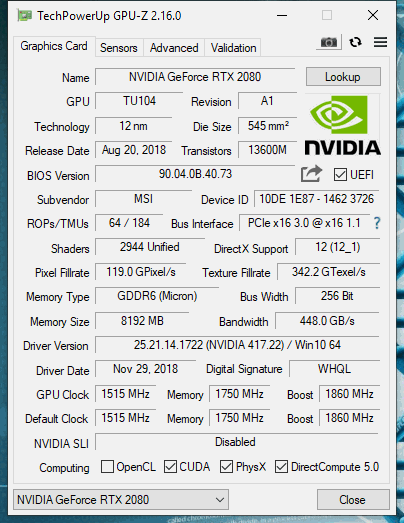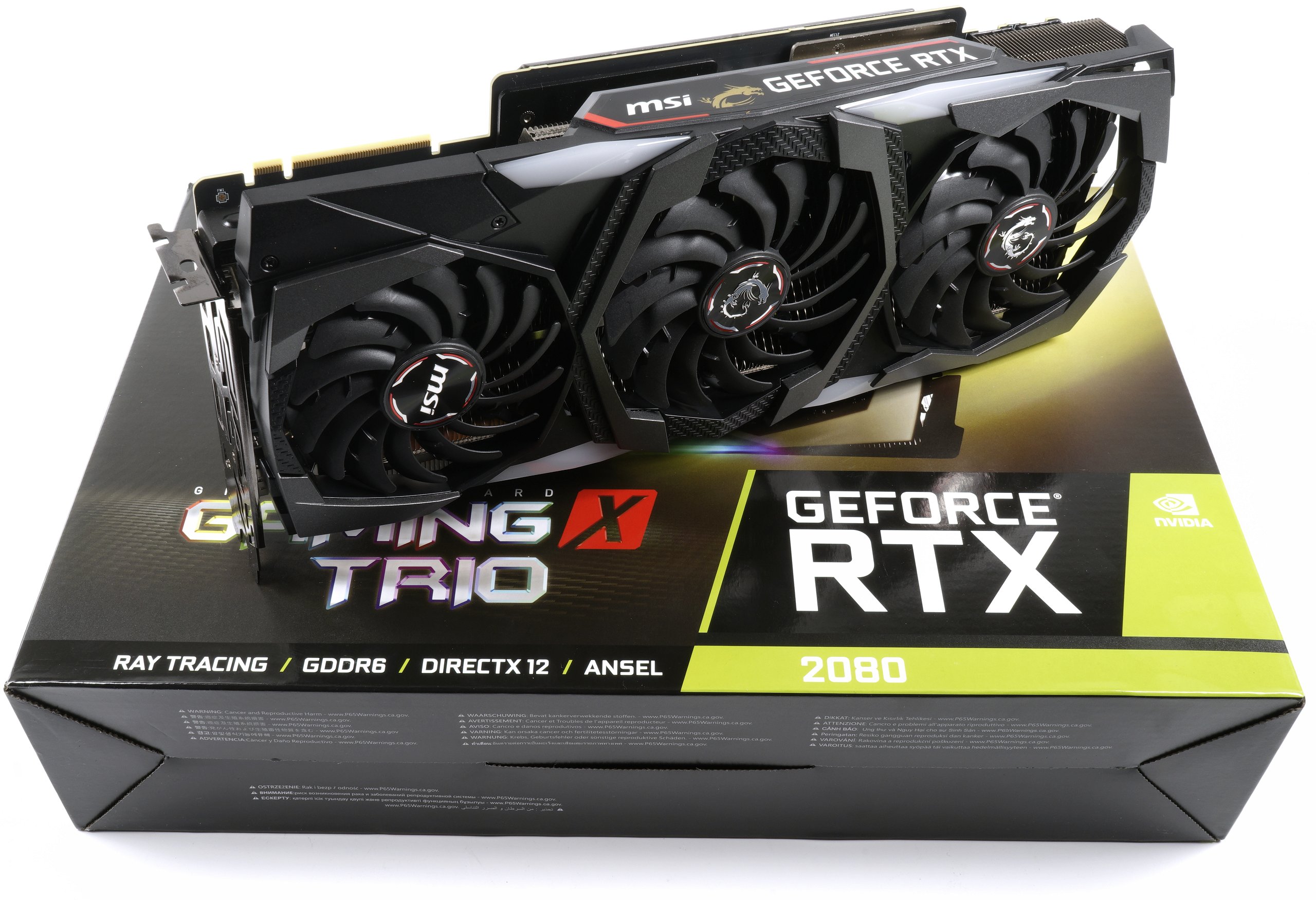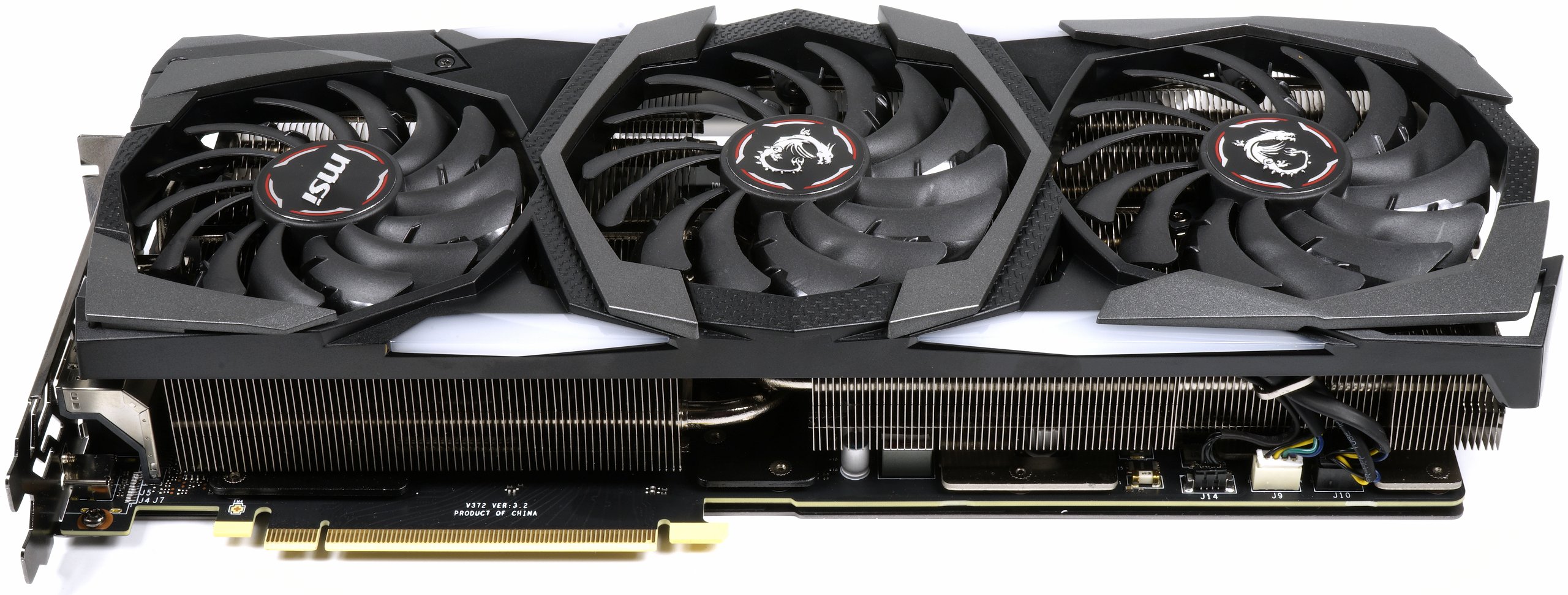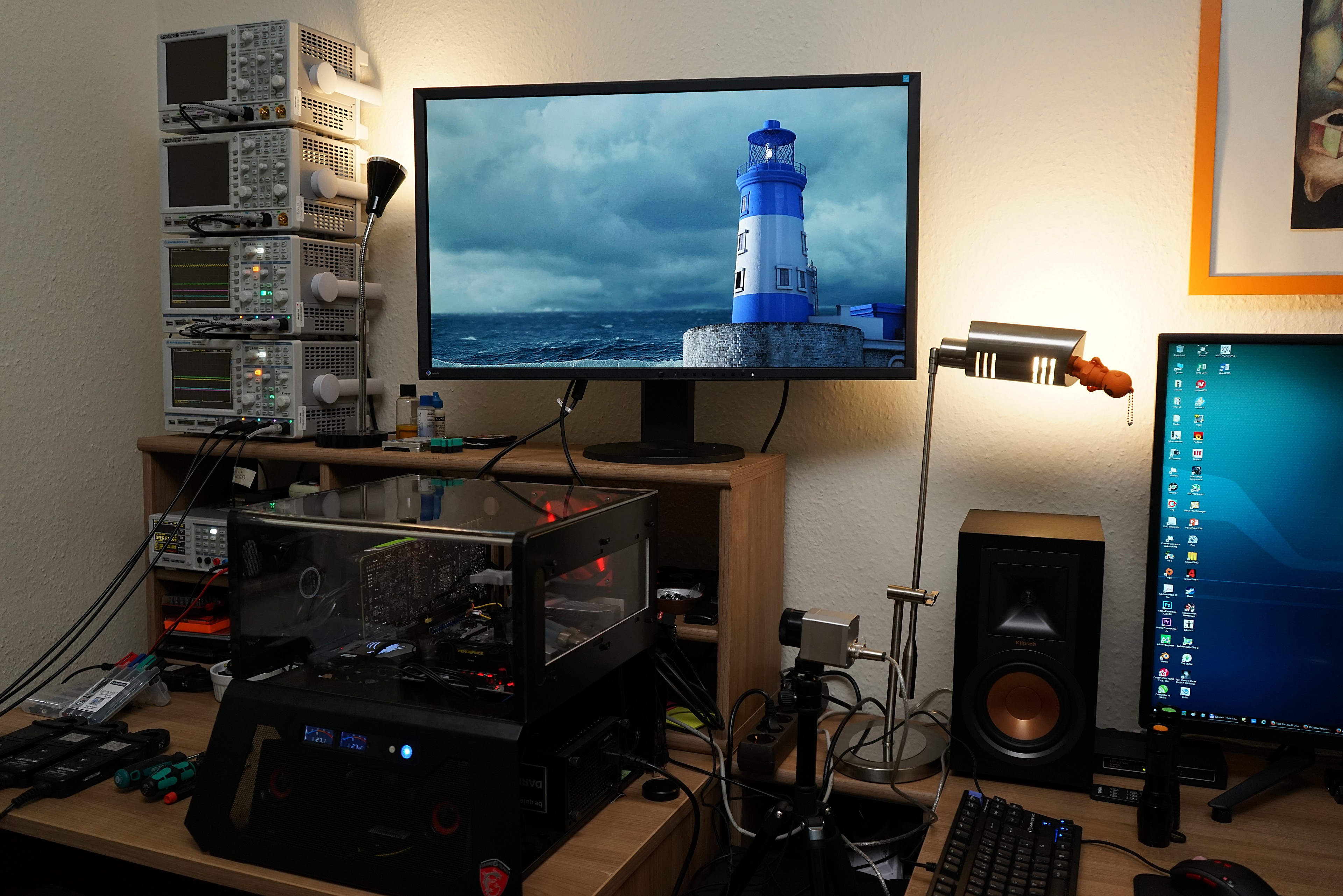I took a closer look at the MSI GeForce RTX 2080 Gaming X Trio and found that MSI does not offer a recycled shrinkage of the already tested GeForce RTX 2080 Ti Gaming X Trio, but is already a bit of a bigger part of the board and also the cooler. Map distinguishes. This doesn't even have to be a disadvantage in terms of performance and cooling, if you just do it smartly enough. But for that I have the test and colorful enough the card is always.
The 1525 heavy card is a whopping 32.5 cm long, measures 13.5 cm from top edge slot panel to top edge graphic card case and is 5 cm thick. In addition, there is another 0.5 cm for the backplate in brush look. This allows it to quickly encounter space problems if the housings are too small. The cover is made of plastic in the base and of course there is still a lot of (background) illuminated area on the front and bottom, which can be regulated by driver and can also be switched off . This includes the GeForce logo on the top.
The sheer length also results from the fan assembly with two 9.5 cm fans and an 8.5 cm fan, all with 14 rotor blades, the cooling fins of the approximately one kilo heavy heat sink are arranged vertically and in two blocks. A thick 8 mm heat pipe and five 6 mm heatpipes then distribute the waste heat to the said cooling fins.
The connection options are analogous to the reference of the normal average. You are offered three DisplayPort1.4, one HDMI2.0 and USB-C jack on the slot panel. MsI delivers this card in contrast to the larger GeForce RTX 2080 Ti Gaming X Trio with "only" two external ATX power supply connections, which you can also need. But more on that. MSI gives the card a maximum power limit of 285 watts, ex works a Power Target of 260 watts is preset.
The screenshot of GPU-Z gives us a first impression:

Technical data and comparison maps
At the end of this introduction, the maps of the new generation and those of the old generation in direct tabular comparison:
| Nvidia GeForce RTX 2080 Ti Fe |
Nvidia GeForce GTX 1080 Ti Fe |
Aorus GeForce RTX 2080 Xtreme |
Nvidia GeForce RTX 2080 Fe |
Nvidia GeForce GTX 1080 Fe |
|
| Architecture (GPU) |
Turing (TU102) | Pascal (GP102) | Turing (TU104) | Turing (TU104) | Pascal (GP104) |
| CUDA Cores |
4352 | 3584 | 2944 | 2944 | 2560 |
| Tensor-Cores |
544 | No | 368 | 368 | No |
| RT-Cores |
68 | No | 48 | 48 | No |
| Texture Units |
272 | 224 | 184 | 184 | 160 |
| Basic clock |
1350 MHz | 1480 MHz | 1515 MHz | 1515 MHz | 1607 MHz |
| Boost clock |
1635 MHz | 1582 MHz | 1860 MHz | 1800 MHz | 1733 MHz |
| Memory |
11GB GDDR6 | 11GB GDDR5X | 8GB GDDR6 | 8GB GDDR6 | 8GB GDDRX5 |
| Storage bus |
352-bit | 352-bit | 256-bit | 256-bit | 256-bit |
| Memory bandwidth |
616 GB/s | 484 GB/s | 448 GB/s | 448 GB/s | 320 GB/s |
| Rops |
88 | 88 | 64 | 64 | 64 |
| L2 Cache |
5.5MB | 2.75MB | 4MB | 4MB | 2MB |
| Tdp |
260W | 250w | 250w | 225W | 180w |
| Transistors |
18.6 billion | 12 billion | 13.6 MRD | 13.6 billion | 7.2 billion |
| Chip size |
754 mm2 | 471 mm2 | 545mm2 | 545 mm2 | 314 mm2 |
| SLI Support |
Yes (x8 NVLink, x2) | Yes (MIO) | Yes (x8 NVLink) | Yes (x8 NVLink) | Yes (MIO) |
Test system and measurement methods
We have already described the new test system and the methodology in detail in the basic article "How We Test Graphics Cards, as of February 2017" and therefore refer to this detailed basis for simplicity. Description. So if you want to read everything again, you are welcome to do so. However, we have again improved CPU and cooling to largely exclude possible CPU bottlenecks for this fast card.
If you are interested, the summary in table form quickly provides a brief overview:
| Test systems and measuring rooms | |
|---|---|
| Hardware: |
Intel Core i7-8700K x 5 GHz MSI Z370 Gaming Pro Carbon AC 16GB KFA2 DDR4 4000 Hall of Fame 1x 1 TByte Toshiba OCZ RD400 (M.2, System SSD) 2x 960 GByte Toshiba OCZ TR150 (Storage, Images) Be Quiet Dark Power Pro 11, 850-watt power supply |
| Cooling: |
Alphacool Ice Block XPX 5x Be Quiet! Silent Wings 3 PWM (Closed Case Simulation) Thermal Grizzly Kryonaut (for cooler change) |
| Housing: |
Lian Li PC-T70 with expansion kit and modifications Modes: Open Benchtable, Closed Case |
| Monitor: | Eizo EV3237-BK |
| Power consumption: |
non-contact DC measurement on the PCIe slot (Riser-Card) non-contact DC measurement on the external PCIe power supply Direct voltage measurement on the respective feeders and on the power supply 2x Rohde & Schwarz HMO 3054, 500 MHz multi-channel oscillograph with memory function 4x Rohde & Schwarz HZO50, current togor adapter (1 mA to 30 A, 100 KHz, DC) 4x Rohde & Schwarz HZ355, touch divider (10:1, 500 MHz) 1x Rohde & Schwarz HMC 8012, digital multimeter with storage function |
| Thermography: |
Optris PI640, infrared camera PI Connect evaluation software with profiles |
| Acoustics: |
NTI Audio M2211 (with calibration file) Steinberg UR12 (with phantom power for the microphones) Creative X7, Smaart v.7 own low-reflection measuring room, 3.5 x 1.8 x 2.2 m (LxTxH) Axial measurements, perpendicular to the center of the sound source(s), measuring distance 50 cm Noise in dBA (Slow) as RTA measurement Frequency spectrum as a graph |
| Operating system | Windows 10 Pro (1803, all updates) |











































Kommentieren